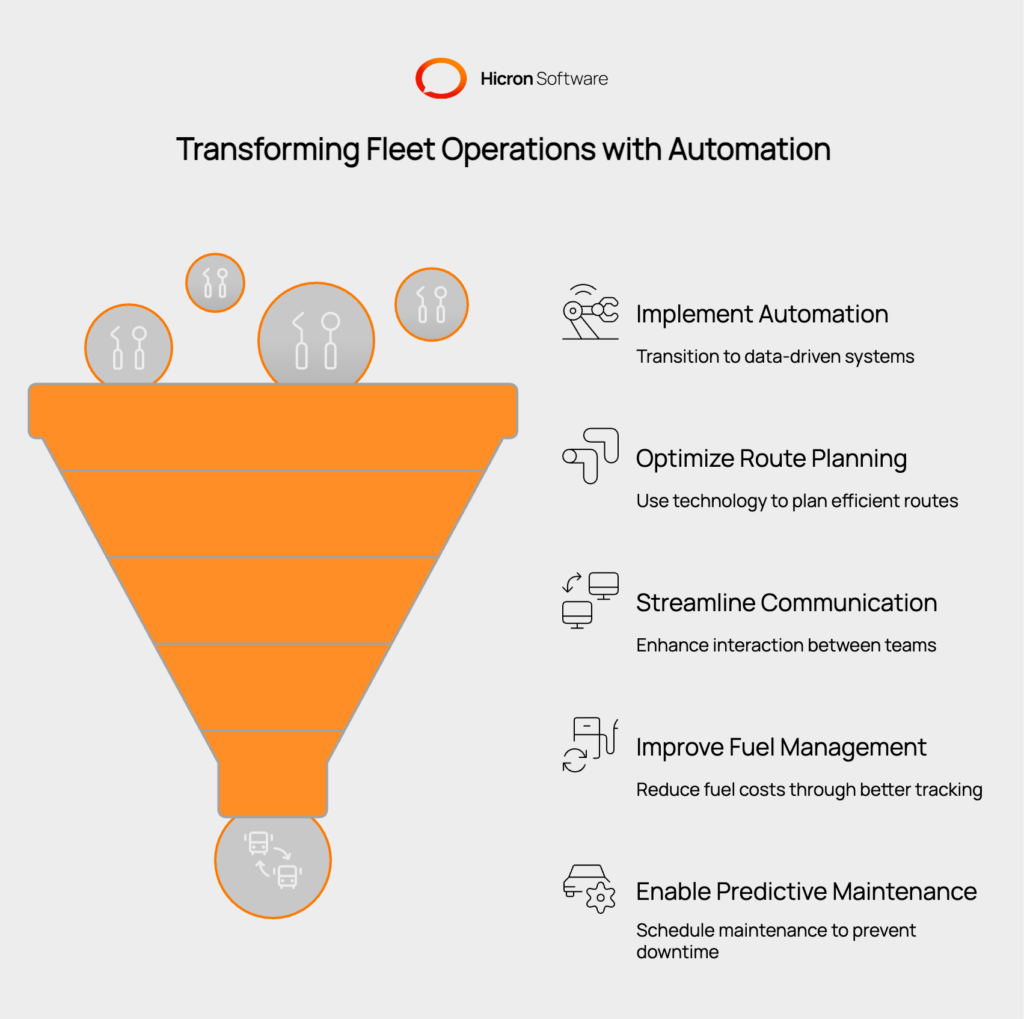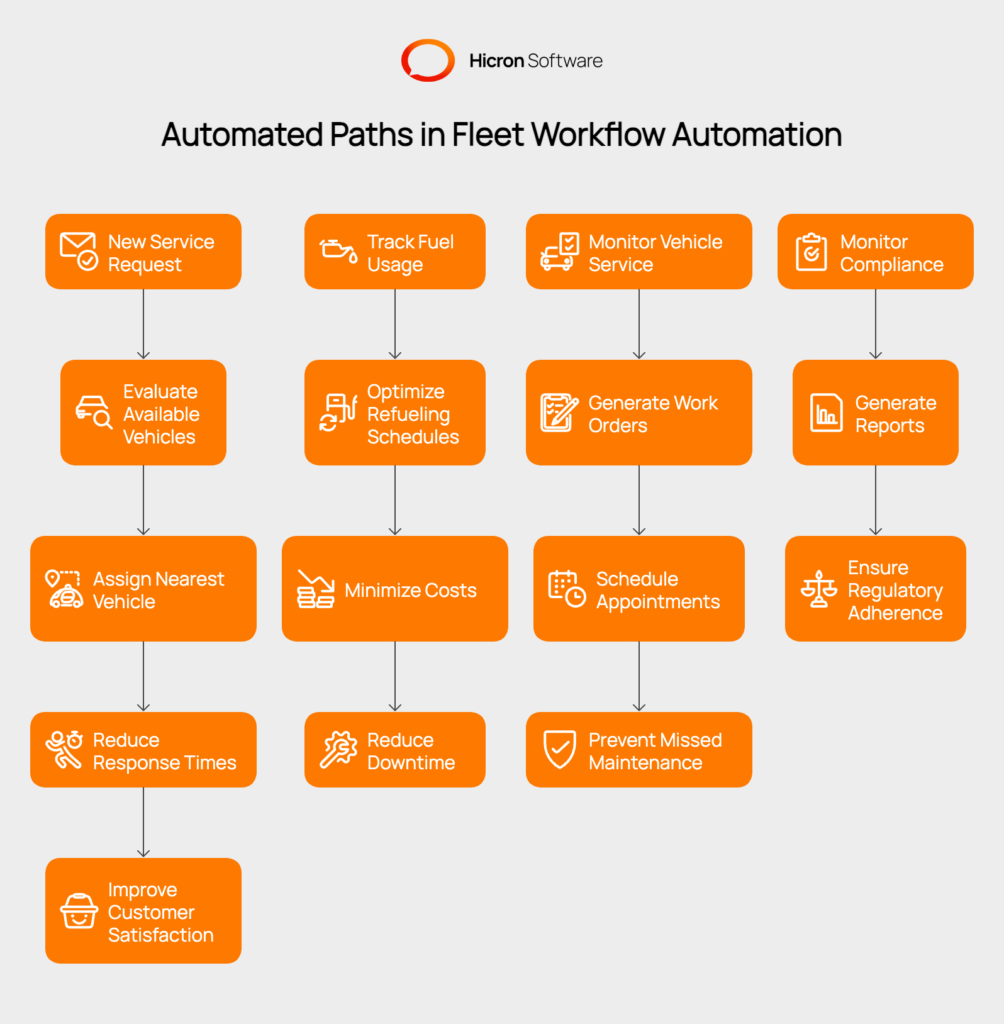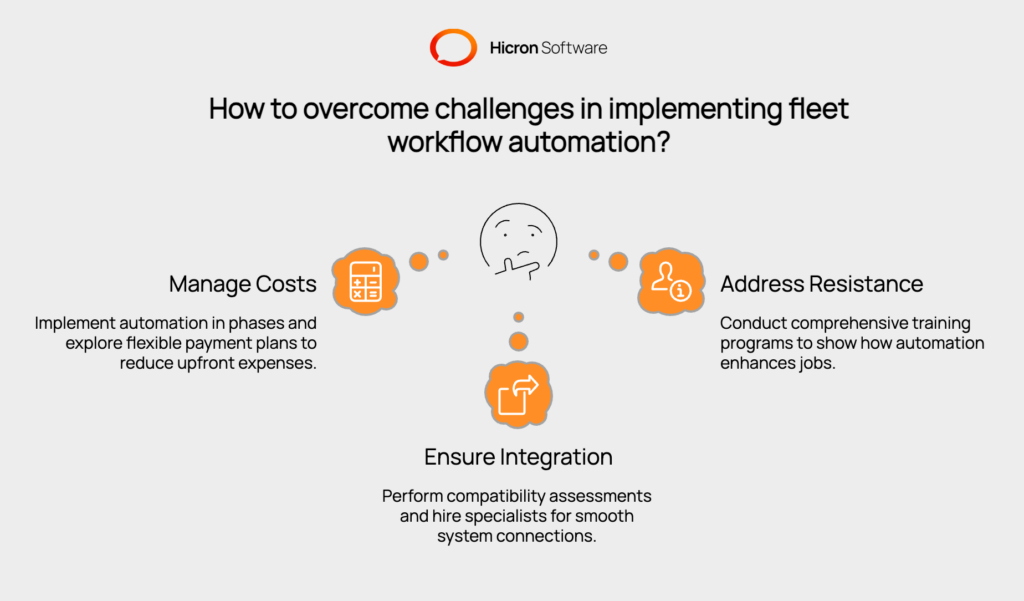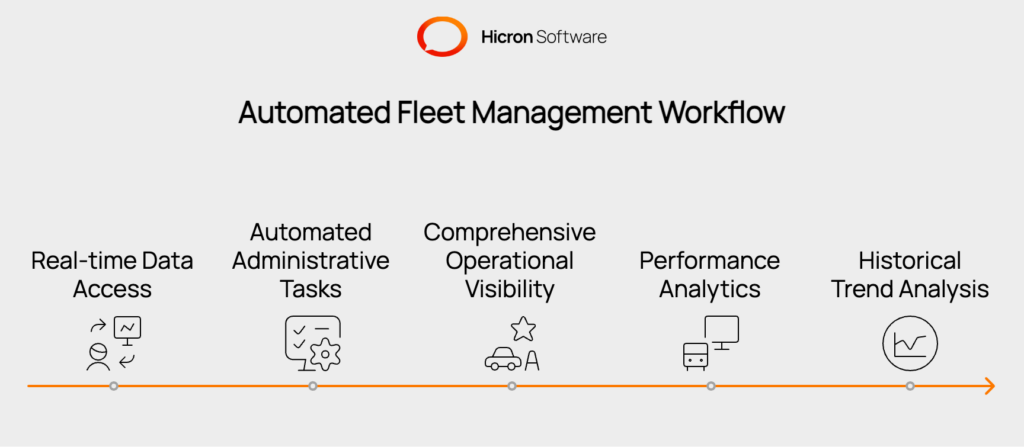Automotive Spare Parts Management: A Critical Aspect of After-Sales Processes
- February 14
- 18 min

Fleet workflow automation uses technology to handle routine fleet management tasks such as dispatching, route planning, and maintenance scheduling. By reducing manual intervention, it streamlines operations and improves efficiency. This approach helps lower costs, minimizes errors, and gives managers better insight into fleet performance.
Modern fleet managers face increasing pressure to cut costs, improve efficiency, and maintain compliance across their operations. With rising fuel costs and growing regulatory requirements, manual fleet management processes are no longer sustainable for businesses that want to stay competitive.
This comprehensive guide explores how fleet workflow automation can transform your operations, covering everything from essential features to implementation challenges. Whether you’re managing 10 vehicles or 1,000, automation offers proven ways to boost performance and reduce costs.
Key Takeaways:
Fleet workflow automation transforms operations by replacing time-consuming manual processes with intelligent, data-driven systems. Instead of relying on spreadsheets and phone calls, fleet managers can now monitor their entire operation from a single dashboard.
Fleet workflow automation addresses many challenges that manual processes cannot handle. Automated systems improve operational efficiency by eliminating repetitive administrative tasks. They help
These technologies can reduce operational costs by
Real-time tracking and monitoring provide complete visibility into vehicle locations, driver behavior, and fuel consumption. This transparency allows managers to make informed decisions quickly, whether redirecting vehicles to avoid traffic or identifying drivers who need additional training.

Modern fleet automation system supports data-driven decision-making by providing managers with comprehensive analytics and real-time insights. This allows managers to
Reduced manual errors and operational bottlenecks create immediate cost savings. When dispatchers no longer need to manually assign jobs or track vehicle status, they can focus on higher-value activities like customer service and strategic planning. This shift improves both productivity and job satisfaction.
When evaluating fleet automation platforms, focus on features that directly impact your operational challenges and business goals.
|
Feature |
Description |
Key Benefits |
|
Real-time Tracking and Monitoring |
Provides continuous oversight of fleet performance, location, driver behavior, fuel consumption, and route optimization with instant alerts for deviations |
Enhanced safety through behavior monitoring, improved route efficiency, reduced fuel costs, immediate response to operational issues |
|
Predictive Maintenance |
Analyzes engine diagnostics, mileage patterns, and historical data to forecast potential component failures before they occur |
Minimized vehicle downtime, prevention of costly emergency repairs, optimal vehicle performance throughout lifecycle |
|
Customizable Dashboards |
Offers flexible data visualization tailored to specific stakeholder needs, from executive KPIs to detailed maintenance data |
Improved decision-making through relevant data presentation, adaptability to changing requirements, stakeholder-specific insights |
|
System Integration |
Ensures connectivity with existing telematics devices, ERP software, and other business tools through APIs and pre-built connections |
Eliminates data silos, maximizes automation effectiveness, streamlined workflows across business systems |
|
Scalability |
Provides modular solutions that accommodate fleet growth from small to large operations without requiring complete system overhauls |
Cost-effective expansion capability, future-proof investment, flexible pricing and feature additions as needs evolve |
Real-time tracking and monitoring enables managers to oversee fleet performance and location continuously. This capability goes beyond simple GPS tracking to include driver behavior monitoring, fuel consumption analysis, and route optimization. Look for systems that provide instant alerts when vehicles deviate from planned routes or when drivers exhibit unsafe behaviors.
Predictive maintenance capabilities proactively address vehicle issues to minimize downtime. Advanced systems analyze engine diagnostics, mileage patterns, and historical maintenance data to predict when components might fail. This approach prevents costly breakdowns and helps maintain optimal vehicle performance throughout their lifecycle.
Customizable dashboards allow managers to tailor data visualization to their specific needs. Different stakeholders require different information. Executives want high-level KPIs while maintenance managers need detailed vehicle health data. The best platforms offer flexible dashboard configurations that can be adjusted as needs change.
Integration with existing systems ensures smooth connectivity with telematics devices, ERP software, and other business tools. Without proper integration, automation systems create data silos that limit their effectiveness. Look for platforms that offer robust APIs and pre-built connections to popular fleet management tools.
Scalability ensures the solution can grow with your fleet’s needs. A system that works well for 50 vehicles should also handle 500 without requiring a complete overhaul. Scalable platforms typically offer modular pricing and can add new features as your requirements evolve.
These features are critical for optimizing fleet management and achieving return on investment. The most successful implementations focus on solving specific business problems rather than simply adopting the latest technology.
Automated paths streamline repetitive tasks by creating logical workflows that respond to specific triggers and conditions. These pre-configured processes eliminate the need for constant manual intervention while ensuring consistent execution of important tasks.

Automated vehicle dispatching assigns the nearest available vehicle to each job based on location, capacity, and driver qualifications. When a new service request comes in, the system instantly evaluates all available options and makes optimal assignments. This process reduces response times and fuel consumption while improving customer satisfaction.
Automated fuel management tracks fuel usage patterns and optimizes refueling schedules to minimize costs and downtime. The system monitors fuel levels across the fleet and sends alerts when vehicles need refueling. Some advanced platforms even identify the most cost-effective fuel stations along planned routes.
Automated maintenance alerts notify managers when vehicles are due for service based on mileage, engine hours, or time intervals. Instead of manually tracking service schedules for each vehicle, the system generates work orders and schedules appointments automatically. This approach prevents missed maintenance and helps maintain warranty compliance.
Automated compliance tracking ensures adherence to regulations without manual record-keeping. The system monitors driver hours, vehicle inspections, and safety requirements, generating reports for regulatory agencies. This capability is particularly valuable for fleets operating across multiple jurisdictions with different compliance requirements.
These automated paths reduce manual intervention, save time, and enhance overall fleet performance by ensuring that critical tasks are completed consistently and on schedule.
Fleet workflow automation relies on advanced technologies that work together to deliver comprehensive operational visibility and control.
|
Technology |
Functionality |
Benefits |
|
GPS Tracking Systems |
Provide real-time vehicle monitoring with accurate location data, movement history, speed monitoring, idle time tracking, and route adherence |
Optimize routes, reduce fuel consumption, improve customer service through better visibility |
|
Telematics Devices |
Collect and analyze vehicle data by plugging into diagnostic ports to monitor engine performance, driver behavior, fuel consumption, braking patterns, and fault codes |
Identify training opportunities, prevent costly repairs, enhance driver safety through behavior insights |
|
AI-Powered Predictive Maintenance Tools |
Analyze historical data and identify patterns to forecast potential vehicle issues before they occur using machine learning algorithms |
Reduce maintenance costs, prevent unexpected breakdowns, improve prediction accuracy over time |
|
Cloud-Based Fleet Management Platforms |
Centralize control and data access, enabling remote monitoring with automatic updates, data backup, and scalability |
Enable real-time collaboration, eliminate on-site IT infrastructure needs, provide anywhere access |
|
IoT Sensors |
Monitor real-time vehicle health and performance including tire pressure, cargo temperature, and various vehicle components |
Detect problems early, ensure regulatory compliance, maintain product quality for specialized transport |
GPS tracking systems enable real-time vehicle monitoring by providing accurate location data and movement history. Modern GPS systems monitor speed, idle time, and route adherence. This information helps managers optimize routes, reduce fuel consumption, and improve customer service.
Telematics devices collect and analyze vehicle data for actionable insights about engine performance, driver behavior, and maintenance needs. These devices plug directly into vehicle diagnostic ports to gather information about fuel consumption, harsh braking, rapid acceleration, and engine fault codes. The data helps managers identify training opportunities and prevent costly repairs.
AI-powered predictive maintenance tools forecast potential issues before they occur by analyzing historical data and identifying patterns that indicate impending failures. Machine learning algorithms become more accurate over time, learning from each maintenance event to improve future predictions. This technology can reduce maintenance costs while preventing unexpected breakdowns.
Cloud-based fleet management platforms centralize control and data access, allowing managers to monitor operations from anywhere with an internet connection. Cloud platforms offer automatic updates, data backup, and scalability without requiring on-site IT infrastructure. They also enable real-time collaboration between dispatchers, drivers, and maintenance teams.
IoT sensors provide real-time insights into vehicle health and performance by monitoring everything from tire pressure to cargo temperature. These sensors can detect problems early and alert managers before they become serious issues. For specialized fleets like refrigerated transport, IoT sensors ensure product quality and regulatory compliance.
These technologies work together to create a robust automation ecosystem that provides comprehensive visibility and control over fleet operations.
Implementing fleet workflow automation presents several challenges that require careful planning and strategic approaches to overcome successfully.

The importance of planning and support cannot be overstated when implementing fleet workflow automation. Successful projects begin with
Regular communication with all stakeholders helps address concerns early and maintains momentum throughout the implementation process.
Selecting an appropriate fleet automation solution delivers measurable improvements across multiple areas of operation.
Companies that have successfully implemented fleet automation report improved customer satisfaction due to better service reliability and faster response times. Real-time tracking allows accurate delivery estimates, while optimized routing reduces delays and missed appointments.
Fleet automation workflows provide managers with several key operational benefits that enhance daily performance and strategic planning.

When considering fleet workflow automation, one of the most important decisions is whether to adopt a ready-made platform or invest in developing a custom solution tailored to your business needs.
Ready-made solutions offer the advantages of rapid deployment, tested reliability, and access to ongoing updates and vendor support. They are typically easier to implement, with standardized features that accommodate most standard operational requirements. This approach can reduce upfront costs and minimize internal resource demands. However, off-the-shelf platforms may lack some of the unique features or workflow customizations your business requires, and you may be limited by their available integrations and update schedules.
In contrast, developing a tailored solution allows you to design every feature around your specific processes and challenges. Custom fleet workflow automation platforms can
The major considerations with this approach are higher initial costs, a longer development timeline, and the necessity of dedicated internal or external technical expertise for both initial build and ongoing maintenance.
|
Step |
Description |
Key Considerations |
|
1. Identify Needs |
Document current pain points and fleet challenges |
Create detailed requirements list with essential and nice-to-have features |
|
2. Compare Solutions |
Systematically evaluate available platforms |
Features, pricing, scalability; request targeted demonstrations; assess user interface design and ease of use |
|
3. Assess Support |
Research vendor reputation and support quality |
Customer references, online reviews, training programs, ongoing support availability, implementation timelines |
|
4. Future-Proof Investment |
Select adaptable solutions for business growth |
Cloud-based architecture, API availability, upgrade policies, regular updates without expensive migrations |
Weigh the pros and cons of both options relative to your
For businesses with complex, evolving requirements, a custom solution may offer lasting value. If your needs align closely with mainstream features and you want a faster rollout, a ready-made platform could be the better fit.
Careful assessment at this stage sets the foundation for long-term success with fleet workflow automation. Consider factors like
The best fleet workflow automation platforms offer regular updates and new features without requiring expensive migrations or system replacements.
Fleet workflow automation represents a fundamental shift in how modern businesses manage their vehicle operations. The technology eliminates manual inefficiencies while providing the real-time visibility needed to make informed decisions quickly.
Success depends on focusing on key features that address your specific operational challenges, from predictive maintenance capabilities to real-time tracking systems. The most effective implementations combine the right technology with proper planning, comprehensive training, and ongoing optimization.
The benefits of fleet workflow automation extend beyond cost savings to include improved safety, better customer service, and enhanced competitive positioning. Organizations that embrace automation today will be better positioned to handle future challenges and growth opportunities.
Get in touch and start evaluating fleet automation solutions today to unlock the efficiency, cost savings, and improved performance your business needs to succeed in an increasingly competitive marketplace.
Most organizations see positive returns within 12-18 months of implementation. Quick wins from reduced fuel costs and improved efficiency often appear within the first quarter, while longer-term benefits from predictive maintenance and asset optimization develop over time.
Training requirements vary based on system complexity and user roles. Most modern platforms feature intuitive interfaces that reduce training time. Expect 1-2 days for basic users and 3-5 days for administrators. Ongoing support and refresher training help ensure continued success.
Most leading fleet automation platforms offer integration capabilities with popular telematics providers. However, compatibility should be verified during the evaluation process. Some systems may require hardware upgrades or replacement to achieve full functionality.
Fleet automation provides benefits for organizations with as few as 10 vehicles, though the specific features and ROI calculations vary by fleet size. Larger fleets typically see greater absolute savings, while smaller fleets may achieve higher percentage improvements in efficiency.
Choose vendors that offer enterprise-grade security features including data encryption, regular backups, and compliance with industry standards. Review security certifications, ask about data center locations, and understand data ownership policies before making a decision.
